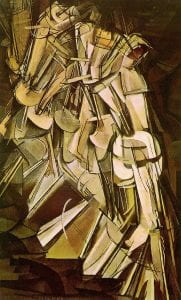What is a Manifesto?
A manifesto is an artistic declaration of intent, in regard to the style and movement of an artwork or artist. They can be used to express the typical views and themes of the artist or movement, whether this is maintaining or (more often) diverting the status quo, and usually the characteristics of the manifesto remain continuous throughout the whole movement in order to relay a certain message to the audience.
In order to create my own manifesto, I need to think about what motivates me, and my views and beliefs on how I perceive my work. I need to take into consideration that I value hard work and diligence, as well as finding equal balance between trying my best and giving myself time and room to breathe. I want my manifesto to reflect how stress can become a real struggle sometimes, and that I show focus on my own wellbeing as well as the quality of my work. I want to remember that there is always a solution to anything.
Cubist (1912)
The manifesto for the Cubist movement, in 1912, was also known as Du “Cubisme” (in English, meaning “On Cubism”). The book featured the works of artists such as Paul Cézanne, Juan Gris and Pablo Picasso, as well as many others. The movement focused mainly on breaking down scenes and objects into much simpler forms and shapes, with an emphasis on deterring from normal viewpoints. The results of these works often appeared fragmented, with small pieces coming together to form a sort of collage.
Main characteristics of the Cubist movement:
- Flat
- Two-dimensional
- Non-traditional perspective
- Foreshortening
- Fragmentation
I like this movement for how open it is for interpretation. There is still an element of the original image, but it has been distorted and changed to the point of being almost indistinguishable. The abstract-like shapes found within the cubist pieces give it a strange sense of dimension, making it seem flat and collage-like.
Dada (1916)
In 1916, the artist Hugo Ball released the first manifesto for the Dada movement, where collected the main themes of the movement. In this, he went on to explain how Dada literally means “goodbye”, as in, leaving behind the norm. It was a way of expressing freedom of emotion and thoughts, especially in a time where freedom of speech was very important.
Main characteristics of the Dada movement:
- Humorous
- Creative freedom
- Emotionally reactive
- Mocking of authority
- Absurd
I like the craziness that the Dada movement seems to possess. In once piece, there is so much going on, your eye is immediately drawn all over to make some sense of what it is you are seeing. It is arranged chaos. I love artists in the Dada movement were never afraid of saying or doing what they thought was right, or what they thought would bring humour to their audience, in the way of mocking authority and what had become the norm to them in the news and so forth.
Surrealist (1924)
In 1912, the artist André Breton published a booklet titled, “Editions de Sagittaire”. In this, he defines the Surrealist manifesto as follows:
“Psychic automatism in its pure state, by which one proposes to express—verbally, by means of the written word, or in any other manner—the actual functioning of thought. Dictated by thought, in the absence of any control exercised by reason, exempt from any aesthetic or moral concern.”
Main characteristics of the Surrealist movement:
- Dream-like
- Extra-ordinary
- Imaginative
- Puns and symbols
Surrealism was a very broad movement in terms of subject matter. It included anything and everything, because the main inspirations were thoughts and dreams. I really like this idea, as it brings up questions in your work and lets people interpret it in a number of unique ways.
Creating a Manifesto
I want my manifesto to invoke dedication and persistence. I want to be able to portray the understanding that you cannot always be at your best, and that it is okay to fail from time to time.
Here are a few quotes I have considered:
- It always seems impossible until it’s done.
- Strive for progress, not perfection.
- It’s not going to be easy, but it’s going to be worth it.
In order to come up with ideas for this project, I compiled a collection of sources in which to focus my research on:
I proceeded to create a few sketches of my initial ideas:








